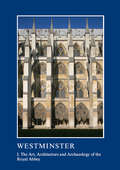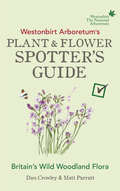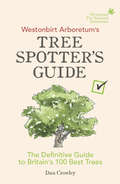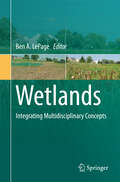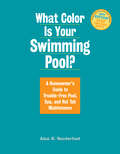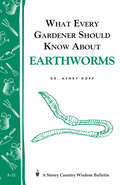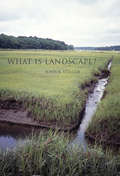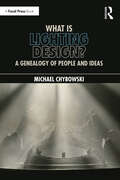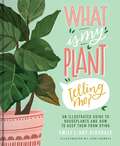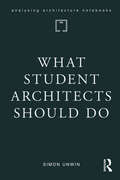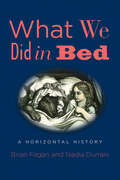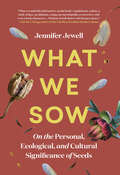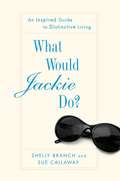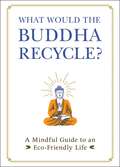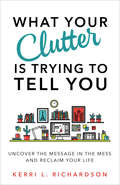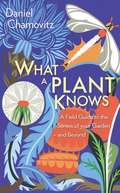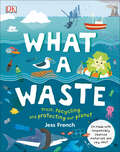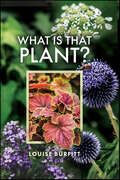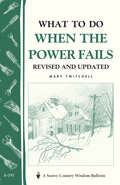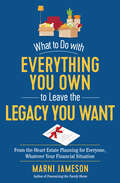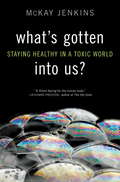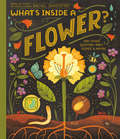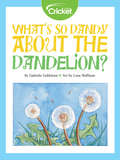- Table View
- List View
Westminster Part I: The Art, Architecture and Archaeology of the Royal Abbey (The British Archaeological Association Conference Transactions)
by Warwick Rodwell; Tim Tatton-BrownThe British Archaeological Association’s 2013 conference was devoted to the study of Westminster Abbey and the Palace of Westminster. It also embraced Westminster School, which was founded at the Reformation in the Abbey precinct. Collectively, these institutions occupy a remarkable assemblage of medieval and later buildings, most of which are well documented. Although the Association had held a conference at Westminster in 1902, this was the first time that the internationally important complex of historic buildings was examined holistically, and the papers published here cover a wide range of subject matter. Westminster came into existence in the later Anglo-Saxon period, and by the mid-11th century, when Edward the Confessor’s great new abbey was built, it was a major royal centre two miles south-west of the City of London. Within a century or so, it had become the principal seat of government in England, and this series of twenty-eight papers covers new research on the topography, buildings, art-history, architecture and archaeology of Westminster’s two great establishments — Abbey and Palace. Part I begins with studies of the topography of the area, an account of its Roman-period finds and an historiographical overview of the archaeology of the Abbey. Edward the Confessor’s enigmatic church plan is discussed and the evidence for later Romanesque structures is assembled for the first time. Five papers examine aspects of Henry III’s vast new Abbey church and its decoration. A further four cover aspects of the later medieval period, coronation, and Sir George Gilbert Scott’s impact as the Abbey’s greatest Surveyor of the Fabric. A pair of papers examines the development of the northern precinct of the Abbey, around St Margaret’s Church, and the remarkable buildings of Westminster School, created within the remains of the monastery in the 17th and 18th centuries. Part II part deals with the Palace of Westminster and its wider topography between the late 11th century and the devastating fire of 1834 that largely destroyed the medieval palace. William Rufus’s enormous hall and its famous roofs are completely reassessed, and comparisons discussed between this structure and the great hall at Caen. Other essays reconsider Henry III’s palace, St Stephen’s chapel, the king’s great chamber (the ‘Painted Chamber’) and the enigmatic Jewel Tower. The final papers examine the meeting places of Parliament and the living accommodation of the MPs who attended it, the topography of the Palace between the Reformation and the fire of 1834, and the building of the New Palace which is better known today as the Houses of Parliament.
Westonbirt Arboretum’s Plant and Flower Spotter’s Guide
by Dan Crowley Matt ParrattGet back to nature with this easy to use guide to Britain's greenery. From the experts at Westonbirt Arboretum in the depths of the Cotswolds, with one of the most beautiful gardens in the world, comes this beautiful pocket guide covering 100 popular wild plants and flowers.Categorised by type of plant, the simple layout ensures that this text is easy to use ‘on the go’. Meadow Saffron, Sweet Woodruff and Solomon’s Seal are just a few examples of the vibrant entries - each accompanied by two beautiful images and a short description.Illustrated with enchanting colour artwork, depicting each plant and their individual bloom or sprig, this covetable book will educate and entertain with text by two leading experts from the Arboretum and the Forestry Commission.
Westonbirt Arboretum’s Tree Spotter’s Guide: The Definitive Guide to Britain’s 100 Best Trees
by Dan CrowleyIn the depths of the Cotswolds, near Tetbury in Gloucestershire, lies one of the most beautiful tree gardens in the world, known as Westonbirt Arboretum. Here you can find around 15,000 trees, each one lovingly labelled. They offer the perfect, picturesque setting for escaping from the pressures of everyday life.Now, for the first time, 100 of the most popular British trees form the basis of this beautiful pocket guide. Illustrated with artwork depicting the tree and leaf, this covetable little book will educate and entertain with wonderfully concise text by one of the world’s leading tree experts from the Arboretum. Pop this book in your pocket for a great day out spotting some of the most celebrated features of our landscape!
Wetlands
by Ben A. LepageThe science of wetlands and our understanding of these complex ecosystems have improved considerably. The emergence of multidisciplinary strategies is providing new opportunities and innovative approaches to address issues such as climate change and coastal protection. This book, with contributions from 19 specialists from academia, government, and industry, provides a trans-disciplinary approach to the understanding wetlands science, drawing together a wide range of expertise. Topics covered include the physical aspects that shape different wetlands around the world, as well as wetlands ecology, regulation, policy, and related social and economic issues. Featuring contributions from some of the world's leading wetlands researchers and practitioners, this book provides an invaluable resource for undergraduate and post-graduate training in all aspects of wetlands management, conservation, and construction. It is also a useful auxiliary text for researchers working across disciplines in fields such as wetlands science, law, landscape architecture, environmental engineering, conservation ecology, and related disciplines.
What Color Is Your Swimming Pool?: A Homeowner's Guide to Trouble-Free Pool, Spa, and Hot Tub Maintenance
by Alan SanderfootKeep your swimming pool, spa, or hot tub clean and inviting with beautiful sparkling water. Covering all essential maintenance procedures, this easy-to-use guide shows you how to expertly and inexpensively care for your backyard water features. With advice on everything from basic cleaning routines to doing your own repairs, Alan E. Sanderfoot tells you what you need to know about water filtration systems, pumps, motors, heaters, winterizing, and more. Enjoy the pleasures of healthy, crystal-clear water for less money and less trouble! This publication conforms to the EPUB Accessibility specification at WCAG 2.0 Level AA.
What Every Gardener Should Know About Earthworms: Storey's Country Wisdom Bulletin A-21 (Storey Country Wisdom Bulletin Ser.)
by Henry HoppSince 1973, Storey's Country Wisdom Bulletins have offered practical, hands-on instructions designed to help readers master dozens of country living skills quickly and easily. There are now more than 170 titles in this series, and their remarkable popularity reflects the common desire of country and city dwellers alike to cultivate personal independence in everyday life.
What Is Landscape?
by John R. StilgoeA lexicon and guide for discovering the essence of landscape.“Mr. Stilgoe does not ask that we take his book outdoors with us; he believes that reading and experiencing landscapes are activities that should be kept separate. But, as I learned in his book, the hollow storage area in a car driver's door was once a holster, the 'secure nesting place of a pistol.' I recommend you stow your copy there.”—The Wall Street JournalLandscape, John Stilgoe tells us, is a noun. From the old Frisian language (once spoken in coastal parts of the Netherlands and Germany), it meant shoveled land: landschop. Sixteenth-century Englishmen misheard or mispronounced this as landskep, which became landskip, then landscape, designating the surface of the earth shaped for human habitation. In What Is Landscape? Stilgoe maps the discovery of landscape by putting words to things, zeroing in on landscape's essence but also leading sideways expeditions through such sources as children's picture books, folklore, deeds, antique terminology, out-of-print dictionaries, and conversations with locals. (“What is that?” “Well, it's not really a slough, not really, it's a bayou...”) He offers a highly original, cogent, compact, gracefully written narrative lexicon of landscape as word, concept, and path to discoveries.What Is Landscape? is an invitation to walk, to notice, to ask: to see a sandcastle with a pinwheel at the beach and think of Dutch windmills—icons of triumph, markers of territory won from the sea; to walk in the woods and be amused by the Elizabethans' misuse of the Latin silvaticus (people of the woods) to coin the word savages; to see in a suburban front lawn a representation of the meadow of a medieval freehold.Discovering landscape is good exercise for body and for mind. This book is an essential guide and companion to that exercise—to understanding, literally and figuratively, what landscape is.
What Is Lighting Design?: A Genealogy of People and Ideas
by Michael ChybowskiWhat Is Lighting Design?: A Genealogy of People and Ideas explains what lighting design is by looking at the history of ideas that are a part of this craft and how those ideas developed. Lighting design began in the West with the Renaissance, and each historical period since then has modified how and why light is used in performance, the methods for producing light, and the consensus around what its purpose is. Exploring each lighting design era and the basic components of lighting design, the book discusses how the central ideas of this craft developed over the past 500 years, what today’s lighting designers are concerned with, and how lighting design contributes to performances. This book is designed as a main course text for History of Lighting Design university courses and a supplementary text for and Introduction to Lighting Design, Stagecraft, and Scenography courses. It will also be of interest to directors, choreographers, and working lighting designers who wish to explore the history and meaning of their craft.
What Is My Plant Telling Me?: An Illustrated Guide to Houseplants and How to Keep Them Alive
by Emily L. HinsdaleKeep your house plants alive and thriving with this illustrated, accessible guide to popular house plants for new and experienced plant-parents alike.Many new gardeners are finally starting to understand why bringing the outside indoors is so appealing. From improving home décor to mental health, plants have so many benefits. But keeping them alive (and most importantly, thriving) isn&’t always easy! What does it mean if your plant has brown tips? Rotting roots? Yellow leaves? The list goes on. Don&’t you just wish your plants could communicate what&’s wrong and how to fix it? What Is My Plant Telling Me? answers all your plant-based questions making it the perfect companion for anyone interested in keeping their plants looking their best. This illustrated guide to the fifty most popular house plants will show you how to: -Speak your plant&’s language -Identify classic distress signals -Intervene successfully to keep your plants thriving for years to come -Choose plants that work best for your space -Pick the best locations within your home to keep your new plants -Identify the pot size needed when you want to replant -And more! Whether you&’re interested in growing a cactus, orchid, or even the popular Fiddle Leaf Fig, this book is the perfect guide to deciphering the message your plant is telling you and what you can do to revive it.
What Student Architects Should Do (Analysing Architecture Notebooks)
by Simon UnwinAs a first year student the challenges of learning how to do architecture can be daunting. Though not prescribing a particular way (there are as many ways to do architecture as there are architects), this Notebook outlines what you should do to cultivate your own distinctive capacity for architectural design.Architecture is a rich and varied subject, a multifaceted and multidimensional skill. Learning to do it is not easy. It has many subtleties. Becoming fluent can take many years. Informed by decades of discussing architecture and its challenges with students, this Notebook will help you lay foundations for a rewarding career as a creative architect.All Simon Unwin’s books explore architecture not just as a matter of form and space but in terms of its primal driving force, the universal need and desire to make places for life.Each of these Analysing Architecture Notebooks is devoted to a particular theme in understanding the rich and varied workings of architecture. They can be thought of as addenda to the foundation volume Analysing Architecture: the Universal Language of Place-Making, which first appeared in 1997 and has subsequently been enlarged in four further editions. Examining these extra themes as a series of Notebooks, rather than as additional chapters in future editions, allows greater space for more detailed exploration of a wider variety of examples, whilst avoiding the risk of the original book becoming unwieldy.
What To Do When Your Mom or Dad Says Clean Your Room (Kid's Survival Guide)
by Joy BerryThis informative guide provides valuable information on basic house keeping skills, such as making your bed, picking up your suff, cleaning your room, and keep things organized and neat. As the author suggests sometimes children don't know how to do these because they were not taught how to do them.
What We Did in Bed: A Horizontal History
by Brian Fagan Nadia DurraniA social history that pulls back the covers on the most intimate piece of furniture in our lives: &“Entertaining . . . will keep you awake long into the night.&” —Paul Chrystal, author of The History of Sweets Louis XIV ruled France from his bedchamber. Winston Churchill governed Britain from his during World War II. Travelers routinely used to bed down with complete strangers, and whole families shared beds in many preindustrial households. Beds were expensive items—and often for show. Tutankhamun was buried on a golden bed, wealthy Greeks were sent to the afterlife on dining beds, and deceased middle-class Victorians were propped up on a bed in the parlor. In this sweeping social history that spans seventy thousand years, Brian Fagan and Nadia Durrani look at the endlessly varied role of the bed through time. This was a place for sex, death, childbirth, storytelling, and sociability as well as sleeping. But who did what with whom, why, and how could vary incredibly depending on the time and place. It is only in the modern era that the bed has transformed into a private, hidden zone—and its rich social history has largely been forgotten. Includes photographs
What We Sow: On the Personal, Ecological, and Cultural Significance of Seeds
by Jennifer JewellAn insightful, personal, and timely exploration into the wonderful world of seeds. In What We Sow, Jennifer Jewell brings readers on an insightful, year-long journey exploring the outsize impact one of nature's smallest manifestations—the simple seed. She examines our skewed notions where "organic" seeds are grown and sourced, reveals how giant multinational agribusiness has refined and patented the genomes of seeds we rely on for staples like corn and soy, and highlights the efforts of activists working to regain legal access to heirloom seeds that were stolen from Indigenous peoples and people of color. Throughout, readers are invited to share Jewell's personal observations as she marvels at the glory of nature in her Northern California hometown. She admires at the wild seeds she encounters on her short daily walks and is amazed at the range of seed forms, from cups and saucers to vases, candelabras, ocean-going vessels, and airliners. What We Sow is a tale of what we choose to see and what we haven't been taught to see, what we choose to seed and what we choose not to seed. It urgently proves that we must work hard to preserve and protect the great natural diversity of seed.
What Would Jackie Do? An Inspired Guide to Distinctive Living
by Shelly Branch Sue CallawayFrom fashion to finance, a sophisticated and entertaining guide that shows readers how to attain the elegance and practical smarts that defined Jackie O. We can't help but want to be like her: Exuding unmatched poise and style, she continues to fascinate people of all ages. But how would Jackie have handled the twenty-first-century? What would she think about a society that celebrates out-sized egos, instant everything, and casual rules of conduct? How might she dress for the office, scan for a man, accessorize a home, and get away from it all when necessary? With intriguing research, commentary from today's experts, and fond reminiscences from those who knew and admired the first lady of perfection, journalists Shelly Branch and Sue Callaway now offer a sparkling answer to the question, What Would Jackie Do? Applying Jackie's philosophies to every aspect of contemporary life, including relationships, office politics, family matters, and entertaining, What Would Jackie Do?is a trove of advice, featuring: "Noblesse Oblige for Beginners" How Not to be an Interchangeable Woman -- Mastering the Effortless Rich look -- The art of attachment: lessons on sex, marriage, and men of consequence -- Career Whirl: Pearls for Getting Ahead -- Caftan in a Kelly bag: How to travel beautifully -- Behave! Anti-brat strategies for parents -- En Suite Home: Perfecting Your Domestic Pitch -- The next best thing to having Jackie O. as a personal adviser, What Would Jackie Do? reveals the practical wisdom behind an icon and gives all readers a piece of the Jackie mystique, be it of the heart, the mind, or the home.
What Would the Buddha Recycle?: A Mindful Guide to an Eco-Friendly Life
by Adams MediaLive the calm and eco-friendly lifestyle you&’ve always dreamed of with this perfect guide to eco-conscious living for anyone who wants to save the planet and make a difference. In today&’s world, there is a lot that can stress us out. We live in a time when talking about climate change is a hot button issue leading to political movements, youth led protests, and lots of anxiety. From green living to figuring out how you (and your family) can make a difference in your community, this mindful approach is the key to being stress-free as you make a positive impact on the environment. What Would the Buddha Recycle? can help you gain a better understanding of how you impact the world around you in your day-to-day life. And, even better, it can help you pause, reflect, and figure out what changes you can make to protect the world. In this book you&’ll learn how to: -Use natural ingredients in your home for cleaning (lemon juice can help your furniture shine) and pest control (chili pepper can deter ants) -Combine mindful cooking and eating for healthier meals that don&’t hurt the environment and make you feel great -Figure out the right food to keep your beloved pets happy and healthy by choosing natural ingredients and avoiding chemical preservatives -Include your family in your new environmentally friendly ways and raise your children to have a similar mindset about saving the planet -And much more! With advice that covers every area of your daily life, What Would the Buddha Recycle? offers easy changes so you can make a difference and protect the environment all while staying zen in the process.
What Would the Buddha Recycle?: The Zen of Green Living
by Rosemary RobertsIf the Buddha were alive today, he'd be the living embodiment of green living. He'd be collecting cans on the freeway, riding his bike to work, and replacing all his light bulbs one little satori at a time. In this book you can channel His Holiness, reduce your footprint, and experience little Aha! moments when you: - Eat mindfully and lose the meat - Make a Zen garden that nourishes the earth - Choose sustainable clothing - Meditate while walking instead of driving - Let go of attachment to things by giving away belongings Living green is living Zen. Now you can take right action and walk a green talk, starting today -- just think how proud the Buddha would be!
What Your Clutter Is Trying to Tell You
by Kerri L. RichardsonWith practical and warm advice, lifestyle designer and coach Kerri Richardson guides you to accept your clutter as a natural manifestation of your mind, body, and spirit looking out for yourself. It is your soul calling out for you to invest in self-care and to face the fears holding you back from being your best self. Richardson dives into the most common categories of physical clutter and provides efficient and effective steps for clearing the space for your physical, mental, and spiritual well-being to flourish. But more than house and home, Richardson encourages you to clear out the clutter of relationships and habits that have been occupying your time and energy for too long.
What a Plant Knows: A Field Guide to the Senses of Your Garden - and Beyond
by Daniel ChamovitzHow does a Venus flytrap know when to snap shut? Can an orchid get jet lag? Does a tomato plant feel pain when you pluck a fruit from its vines? And does your favourite fern care whether you play Bach or the Beatles? Combining cutting-edge research with lively storytelling, biologist Daniel Chamovitz explores how plants experience our shared Earth - through sight, smell, touch, hearing, memory, and even awareness. Whether you are a green thumb, a science buff, a vegetarian, or simply a nature lover, this rare inside look at the life of plants will surprise and delight.
What a Waste: Trash, Recycling, and Protecting our Planet (Protect the Planet)
by Jess FrenchIn this informative book on recycling for children, you will find everything you need to know about our environment. The good, the bad and the incredibly innovative. From pollution and litter to renewable energy and plastic recycling.This educational book will teach young budding ecologists about how our actions affect planet Earth and the big impact we can make by the little things we do.Did you know that every single plastic toothbrush ever made still exists? Or that there is a floating mass of trash larger than the USA drifting around the Pacific Ocean?It is not all bad news though. While this is a knowledge book that explains where we are going wrong, What a Waste also shows what we are getting right! Discover plans to save our seas. How countries are implementing green projects worldwide, and how to turn waste into something useful. The tiniest everyday changes can make all the difference to ensure our beautiful planet stays lush and teeming with life. It is a lively kid&’s educational book with fabulous illustrations and fun facts about the world broken into easy to digest bite-sized bits. Each page can be looked at in short bursts or longer reads for more detail, making it a great children&’s book for a range of age groups.Get Involved - Make A Difference!Almost everything we do creates waste, from litter and leftovers to factory gases and old gadgets. Find out where it goes, how it affects our planet and what we can do to reduce the problem. From how to make your home more energy and water efficient, to which items can be recycled and tips for grocery shopping, this book is packed full of ideas on how you can get involved to make our planet a better place to live.This environment book for children has a wealth of ideas for becoming a planet-defending hero:- Discover shocking facts about the waste we produce and where it goes- Learn where about our Earth&’s limited resources and how to take some pressure off- Your trash is another man&’s treasure- Small changes to take your home from wasteful to super resource efficient- Dive into saving our oceans and super recycling- And much, much moreWhat a Waste is one of several nature books for kids written by Jess French, a passionate conservationist and veterinarian committed to protecting the beautiful world we live in.
What is that Plant?
by Louise BurfittSpring is the most captivating season of the year for both novice and veteran gardeners as green shoots emerge from bare earth, announcing the promise of beautiful blooms to come. But have you ever found yourself crouched beside a flower bed, puzzling over which plants exactly are pushing their way through the soil? Difficult, but by no means impossible – and this is where this picture-led book, jam-packed with useful information, compelling facts and identification tips for beginners, is at hand. Cataloguing 150 common garden plants found in Britain and Europe, the book covers perennials, flowers, shrubs, weeds and wildflowers as well as a unique section on self-seeding plants, which merrily spread about our gardens and can prove difficult to identify. As well as satisfying your curiosity, identifying the plants in your outdoor space will help you get the most out of your plot. Without knowing which flowers, herbs, shrubs or weeds you are working with, it is impossible to give your garden or allotment the care it needs to thrive. And even those without the luxury of their own outdoor space will find interesting insights on plant names and origins alongside intriguing historical tidbits in this engaging field guide, from the connection between daffodils and dementia in Wales to the controversial history of the hawthorn tree. In this comprehensive directory, you’ll find garden plants organized according to type with hands-on advice for identifying the mystery interlopers in your borders, and information about their height, spread, flowering period and toxicity. Discover a wide array of British garden plants, with practical tips for their care and uses.
What to Do When the Power Fails: Storey's Country Wisdom Bulletin A-191 (Storey Country Wisdom Bulletin Ser.)
by Mary TwitchellSince 1973, Storey's Country Wisdom Bulletins have offered practical, hands-on instructions designed to help readers master dozens of country living skills quickly and easily. There are now more than 170 titles in this series, and their remarkable popularity reflects the common desire of country and city dwellers alike to cultivate personal independence in everyday life.
What to Do with Everything You Own to Leave the Legacy You Want: From-the-heart Estate Planning For Everyone, Whatever Your Financial Situation
by Marni JamesonYou can’t take it with you, but you can ensure that what you leave behind has value and meaning. Whether you want the fruits of your life’s work to benefit your family, the environment, science, human rights, the arts, your church, or another cause dear to you, one thing is certain: It won’t happen unless you plan. What to Do with Everything You Own to Leave the Legacy You Want is a step-by-step, DIY guide to turning your money and “stuff” into something meaningful that will outlast you—whether you are in the prime of life or your later years, single or partnered, have kids or not, are well-off or of modest means. With her trademark practical wisdom, downsizing expert Marni Jameson offers plenty of comfort (and even some laughs) as she guides you through the following: Identifying whom you want to benefit from your legacy Navigating wills, trusts, and other paths to your goals Heading off potential family conflicts Making the best plan for your material assets This book will encourage and inspire you through every step of your final downsizing project, helping you make a positive impact on the people and causes closest to your heart.
What's Gotten into Us? Staying Healthy in a Toxic World
by Mckay JenkinsDo you know what chemicals are in your shampoo? How about your cosmetics? Do you know what's in the plastic water bottles you drink from, or the weed killer in your garage, or your children's pajamas? If you're like most of us, the answer is probably no. But you also probably figured that most of these products were safe, and that someone--the manufacturers, the government--was looking out for you. The truth might surprise you.After experiencing a health scare of his own, journalist McKay Jenkins set out to discover the truth about toxic chemicals, our alarming levels of exposure, and our government's utter failure to regulate them effectively. The result of his two-year journey, What's Gotten into Us?, is a deep, remarkable, and empowering investigation into the threats--biological and environmental--that chemicals now present in our daily lives. It reveals how dangerous, and how common, toxins are in the most ordinary things, and in the most familiar of places: * Our water: Thanks to suburban sprawl and agricultural runoff, 97 percent of our nation's rivers and streams are now contaminated with everything from herbicides to pharmaceutical drugs. * Our bodies: High levels of hormone-disrupting chemicals from cosmetics, flame-retardants from clothing and furniture, even long-banned substances like DDT and lead, are consistently showing up in human blood samples. * Our homes: Many toxins lurk beneath our sinks and in our basements, of course, but did you know that they're also found in wall-to-wall carpeting, plywood, and fabric softeners? * Our yards: Pesticides, fungicides, even common fertilizers--there are enormous, unseen costs to our national obsession with green, weed-free lawns. What's Gotten Into Us? is much more than a wake-up call. It offers numerous practical ways for us to regain some control over our lives, to make our own personal worlds a little less toxic. Inside, you'll find ideas to help you make informed decisions about the products you buy, and to disentangle yourself from unhealthy products you don't need--so that you and your family can start living healthier lives now, and in the years to come. Because, as this book shows, what you don't know can hurt you.From the Hardcover edition.
What's Inside A Flower?: And Other Questions About Science & Nature (What's Inside)
by Rachel IgnotofskyFrom the creator of the New York Times bestseller Women in Science, comes a new nonfiction picture book series ready to grow young scientists by nurturing their curiosity about the natural world--starting with what's inside a flower.Budding backyard scientists can start exploring their world with this stunning introduction to these flowery show-stoppers--from seeds to roots to blooms. Learning how flowers grow gives kids beautiful building blocks of science and inquiry.In the launch of a new nonfiction picture book series, Rachel Ignotofsky's distinctive art style and engaging, informative text clearly answers any questions a child (or adult) could have about flowers.
What's So Dandy About the Dandelion?
by Gabriele GoldstoneThe name dandelion comes from the French for "tooth of the lion." But are these flowers actually dangerous?
